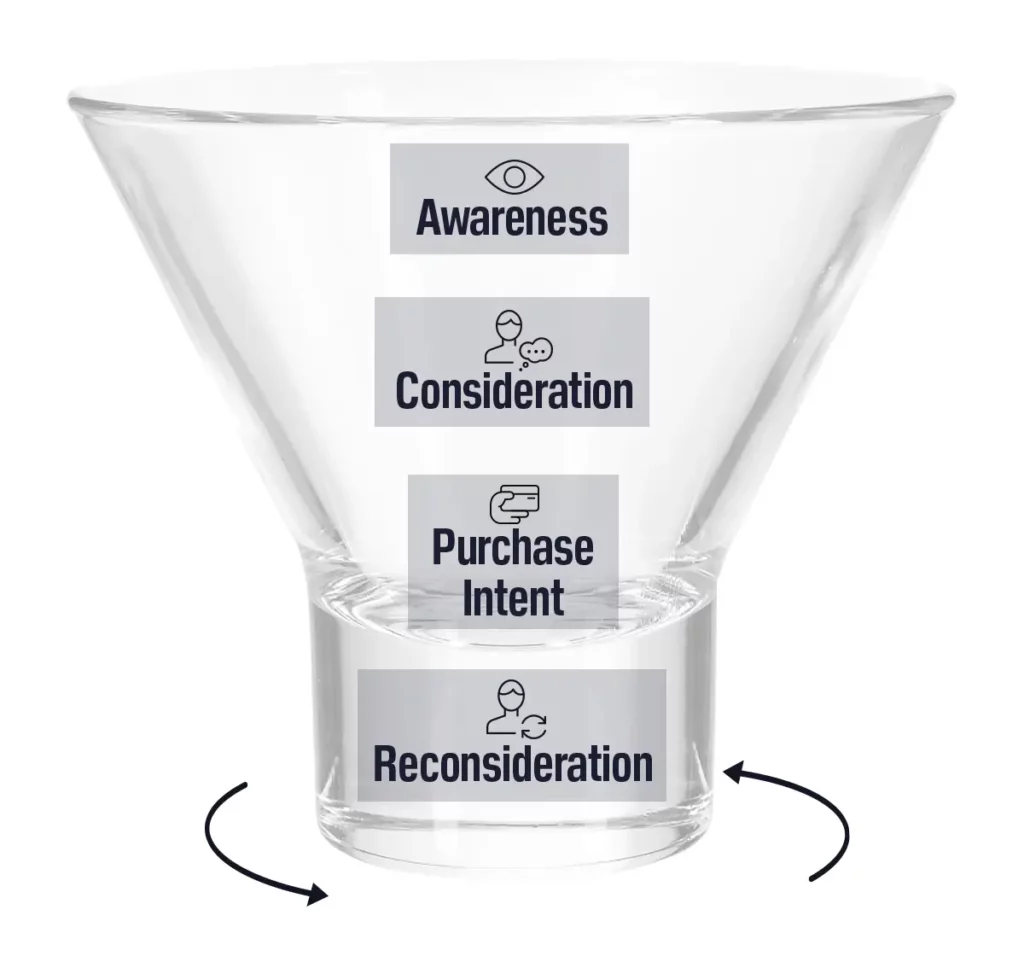The Automotive Purchase Funnel Reconsidered: The Stemless Martini Glass

The automotive industry has withstood major changes in the last three years. Factors such as labor shortages during the pandemic, supply chain backups, rising inflation and microchip shortages have impacted how consumers view the car buying experience. The process and time modern buyers put into the car buying experience have shifted, and brands must adapt to stay competitive.
Let’s dive into the trends behind the new automotive purchase funnel and what they mean for the industry moving forward.
Inventory Challenges Impact Consideration
The traditional purchase funnel includes three stages: awareness, consideration and purchase intent. In the awareness phase, the shopper develops brand recognition. In the consideration phase, the shopper considers each brand, make and model by researching and identifying the best fit. In the last phase, the shopper visits a dealership with the intent to purchase.
But inventory challenges have put pressure on the automotive buyer journey. For multiple years, consumers have struggled to find their ideal make and model at a dealership. Data shows that between 2019 and 2022, new car inventory at dealerships declined 70%. Shoppers who want to make a quick purchase decision need to be open to new options or risk disappointment.
Although inventory continues to improve this year, the days of “stack ‘em deep, sell ‘em cheap” due to excessive inventory are a thing of the past as exemplified by Ford’s and General Motors’ manufacturing pauses. Data shows consumers now spend more time researching their options in the consideration and purchase intent phases.
The Cox Automotive Car Buyer Journey Study indicates customers spent 17% more time researching vehicles last year compared to the previous year. In 2022, online research platform use increased 23% including the use of third-party sites such as Autotrader® plus dealership and automaker sites. The data also shows consumers spent an additional 8% of their time researching at brick-and-mortar dealerships.
Declining Brand Loyalty
Inventory challenges merely add to the fact automotive brand loyalty is already declining. According to the 2022 TruCare Automotive Shopper Trends Report, 77% of car shoppers are brand-agnostic and are open to multiple makes, while 40% of shoppers are open to any make.
With so many outside factors hitting the automotive industry, it’s no surprise brand loyalty is changing. However, one change the industry was less prepared for was how late in the process consumers are changing their minds to makes and models they hadn’t considered. In fact, 70% of shoppers reported changing their minds on models at the dealership, while 21% purchased a make they hadn’t originally considered. Additionally, 20% of shoppers reported purchasing a model they hadn’t considered.
Generational Car Buying Differences
Changes in brand loyalty are also related to generational differences. Younger generations tend to research online and purchase brands they’ve seen advertised more often than the general population.
Autoweek data shows 56% of Gen Z and millennial car buyers are purchasing their first car this year. Because these shoppers are new to the car buying experience, 80% reported the most important element is being able to take their time and understand their options before making a decision. This equates to a greater opportunity for a variety of makes and models to be considered.
On the other hand, older generations are more brand loyal. Research and advertising have a lesser impact on these customers who’ve likely made up their minds before visiting a dealership.
The Stemless Martini Glass Purchase Funnel
When you connect the macroeconomic events shaping the automotive buyer journey, you’ll notice the consideration phase is impacting the typical sales funnel. Whereas the standard straight-line funnel narrows at the purchase intent phase, the new automotive funnel opens back up at the bottom with an added “reconsideration” phase at the end of the buying cycle.
The funnel now takes the shape of a stemless martini glass. Even while at dealerships (and most customers visit two to three dealerships), shoppers are reconsidering secondary options if and when their first choice isn’t available.

Key Takeaways for Automotive Brands
The best way to stay competitive in this new era of automotive buying, aside from keeping your brand and lineup top of mind with in-market consumers, is to stay present throughout the entire buying journey. Your brand must continually educate the reconsideration-phase shoppers on your near-segment models. This will also allow your brand to capitalize on competitors’ potential customers and quasi-brand loyalists who may not be able to fulfill a purchase need immediately.
Many marketers in the automotive industry are also wondering if the buyer journey will return to the traditional funnel once inventory is back up. Cox Automotive data shows the average number of days consumers spend car shopping has decreased from 118 days to 96 days even though the purchase funnel has lengthened. This shows the reconsideration phase was likely always there, but the unique pandemic effects gave us the tools and opportunity to measure it.
Dealers will need to be open to the possibility of further purchase-funnel changes as the industry innovates. As automakers introduce new vehicles and continue to combat supply-chain issues, this pattern is likely to persist and be more pronounced as the U.S. gradually moves from internal combustion engines to electric vehicles.





